 |
6. Proposed Design in July 2017 |
>>Top |
Technical Proposal |
Submissions for Revitalizing the Eastern Buddha Statue in Bamiyan
The Future of the Bamiyan Buddha Statues: Technical Considerations & Potential Effects on Authenticity and Outstanding Universal Value
|
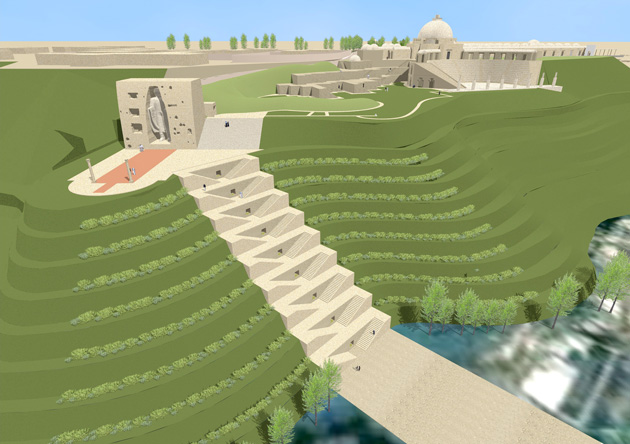 |
Presented by; Collaborative team of Tokyo University of the Arts and Mukogawa Women�fs University |
1. An overall approach to conservation and presentation of the property |
�@The hurdles in the reconstruction=restoration, and the re-presentation of destroyed cultural heritages will never be overcome without implementing vigorous steps, as is the case with war, a never ceasing challenge in the history of mankind. Drastic steps must be taken and raze any prerequisites to counter this serious issue. �@In Afghanistan, great progress has been made since 2002 to protect and restore the World Cultural Heritage of Bamiyan despite many obstacles. The collaborative and cooperative efforts by the United Nations Educational, Scientific and Cultural Organization (UNESCO), international experts, the Government of Afghanistan and the Bamiyan Province are accounted for the achievements. We believe the Revitalization of the East Buddha would be an effective tourism resource for the Bamiyan Province where peace has been sustained even while fighting still persists elsewhere in the country. We propose to utilize the Revitalization to boost overall living standards and social activity, through region-developing-plans including the implementation of better infrastructure, rehabilitation of housing, economic revival, and educational activities. �@Buddhism has been accepted in Japan since ancient times and has continued to develop to the present day. It is an integral element of Japan�fs culture (culturem), and as a consequence, many Buddhist cultural heritages that were lost in disasters or wars have been restored. The Great Buddha in the Todai-ji (The Great Eastern Temple) in Nara is a prime example. The Buddha Statue has been partially recast several times after damaged. Also, murals in Horyuji�fs Kondo hall, which are deeply related to the Bamiyan murals are now in the process of reproduction by patented technology of Tokyo University of the Arts. These reproductions effectively raise more awareness of the cultural heritages. Our activities in Japan however, are not fully applicable to the Bamiyan East Buddha in the sense that the Buddha statue will not be a deity in Afghanistan where Buddhism is not a major religion. A statue of Buddha would be an idol and not be a worship image for Islamic beliefs and because of this reason, other statues including the West Buddha and the standing Buddha in the Kakrak Valley Caves, were also deliberately destructed. Respect and tolerance for other cultures take time to build as they need to be nurtured through the improvement of living standards, broad education and cross cultural exchange. An abrupt reconstruction of the East Buddha may potentially create friction and misunderstandings given the strong symbolic nature of Buddha. The imminent sizable cost may also prove problematic, taking into consideration that some maintenance and repair work on such as niche of West Buddha and some of the important caves still have yet to be completed. �@From these perspective views, we propose the �gRevitalization of the East Buddha�h be a part of cultural heritage conservation and management project that embodies the broad function of a museum, taking constant profit and utilization into account as follows. |
�@
|
On these basis, we propose the following.
|
2. Overall Approach on Safeguarding the Property |
2-1. The Basic Principle on the Proposal of Revitalizing the East Buddha |
�@It is a wide known fact that conservation and management for World Cultural Heritage �gthe Cultural Landscape and Archaeological Remains of the Bamiyan Valley�h (hereafter referred to as The Property) has been carried out under the guidelines and supervisions of expert working groups including the Government of Afghanistan, local community representatives, international experts, UNESCO and other relevant organizations as participants. We strongly commend the continuation of the current process of safeguarding The Property and at the same time, extend our respect to the essence of the World Heritage System as well as the activities of the respective relevant organizations. |
2-2. Proposal to Revitalization the Bamiyan East Buddha |
�@With the aim to promote tourism and regional development by physical revitalizing the East Buddha, we propose a building complex containing three establishments: a museum, a monument in the shape of the East Buddha and an accompanying facility, and storage for fragmented pieces of two great Buddhas. |
2-2-1. A museum suitable for a World Cultural Heritage |
�@We propose to build a museum, as its construction has been requested by the Afghan government and Bamiyan residents for some time. We will design as a unified facility with the monument in the shape of the East Buddha. It will serve to be an all-inclusive central base of The Property, to display, maintain, preserve, repair and research. We hope this facility will convey the historical significance of Bamiyan, and promote a deeper understanding of The Property to the whole world and Afghan people towards reconstruction, and consequently contributing to its safeguarding on many levels. The museum facility will effectively be designed as a functional building while incorporating traditional architectural structure of the Bamiyan region. |
2-2-2. A monument in the shape of East Buddha and an adjoining facility, which new monument catering to Afghan people |
�@We propose to build an entirely new facility inclusive of a monument in the shape of the East Buddha, and an adjacent establishment which would be a reproduction of the niche (hereafter the two combined will be referred to as The New Monument) in an entirely new location within the Bamiyan Valley, that located outside area of buffer zone of The Property, at the same time on a cliff that is homogeneous with the surrounding landscape. The New Monument is a reduced version of the giant East Buddha and would be constructed within the natural landscape of the Cave Garden as part of the museum. |
2-2-3. A storage facility to safeguard the remains of the Buddha |
�@Both of the destructed giant Buddha statues were carved out of sedimentary rocks that formed the Bamiyan Valley. Much of the remains are currently stored in a temporary facility that was constructed through a German initiative. There are many advocates for the fragments to be conserved as a reminder of the tragic events in the recent years. But sedimentary rocks are fragile and are vulnerable to rain and snow. In an endeavor to safeguard the remains in optimal condition, a facility where temperature and humidity can be controlled locally is imperative so they can be displayed and stored for the short- to mid-term. There should be a crane or a similar machine installed within the storage facility to help move heavier remains. The facility will display the remains of the Buddha and how they are carefully conserved and maintained, giving the visitors a glance of the tragic catastrophe that befell the colossal sculptures. |
3. The Guidelines for Adequate Preservation Based on the Outstanding Universal Value(OUV) |
�@In this section, we present the guidelines for conservation and restoration in accordance with the heritage conservation principles and global best practice, siting references from certain charters and treaties. |
3-1. The Proposed New Monument |
3-1-1. Reason for the construction |
�@As aforementioned, we propose to rebuild the East Buddha as a new monument within the Bamiyan Valley, but not within the World Heritage Property. The reason for not reconstructing the Buddha in the original niche is as follows. |
�A The Property represents a diverse cultural landscape reflecting the rise and fall of the Buddhist culture in the area, the advancement of power of Islam, as well as the more recent global situation of the present day. In this context, the 2001 destruction also constitutes OUV. �B An archeological excavation and research of the original spot of the East Buddha has yet to be carried out. As such, a reconstruction at the original location would be deemed as destroying archeological remains and a violation of the World Heritage Convention and other related charters. �C As there have been no archaeological excavation research, subgrade strength and stability need to be assessed. It is unknown whether the ground can withstand such a heavy, grand structure as the giant East Buddha, without triggering possible landslides or causing irreparable damage to other parts of The Property. �D �@ and �A suggest archaeological assessment and geotechnical testing are prerequisites to reconstruct the Buddha in the original niche. In the short run however, either would be difficult, considering the current instability in Afghanistan. �E An overzealous attempt to reconstruct the East Buddha will not be welcomed in Afghanistan as it conflicts with the religious standard of the country. Furthermore, taking in to consideration the current global situation, it is plausible that a reconstruction of the Buddha statue will aggravate religious friction and prompt people with certain beliefs and ideology to intervene. Keeping in lines with the World Heritage Convention that clearly notes World Heritage sites should �gcontribute to the maintenance of world peace,�h we must make sure to eliminate all possibilities of the reconstruction causing any hostility. |
�@Building the East Buddha in the original spot seems ideal in terms of catering to the people of Afghanistan. But technological limitations and unaddressed issues make this a difficult option at the present time. We would have to account for the possible worst case scenario that such a reconstruction may even damage the component parts of The Property. The Bamiyan Buddhas were already once deliberately destroyed by human hands. In the process of this revitalization, we must ensure such a destruction will not be repeated regardless of whether it may be deliberate or not.
In building a brand-new monument in an entirely new spot, our proposal is within the framework of the Operational Guidelines for the World Heritage Centre and more importantly, meets the criteria for OUV including the assessment of authenticity and integrity. This is a reflection of our appreciation, acceptance and respect for the Operational Guidelines. In effect, our proposal to build a new monument, a museum site, and storage facility would contribute to the presentation, interpretation and education of The Property.
|
3-1-2. The new location and the reasons for its selection |
�@The new location for the new monument was selected according to the below conditions (Fig. 1.) |
�A The construction of the new monument at this spot will not interfere with the cultural landscape of The Property �B As it is on the cliff facing the original spot of the two Great Buddhas, it can be visually recognized by more residents �C It is a location that would not intrude in the daily lives of the nearby residents �D It is on a slope that bears no risk of contaminating existing rivers and furthermore, when necessary, can take protective measures on the natural spring at the foothill of the cliff. For this specific reason, the construction would be at the ridge of the slope and not at the base. |
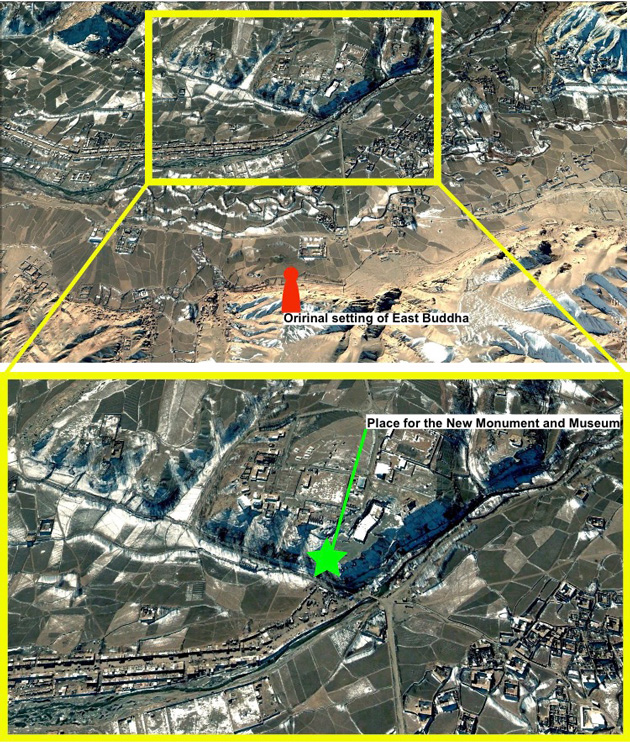 |
Fig. 1. The new location for the Monument and Museum |
3-1-3. The actual process |
�A Build the new monument: Create the reduced size East Buddha, recreate the niche and the surrounding caves (collectively referred to as �gThe New Monument.�h) Replicate the original site pre-2001, using scientific data obtained. In this process, Tokyo University of the Arts�f patented technology of cloning cultural properties will be a great contribution to recreate murals and the interiors of the caves. �B Building the museum: We will build a museum complex adjacent to the New Monument. The building design will be homogeneous with the surrounding environment and will not interfere with the cultural landscape. It will be built using the newest technology combined with traditional workmanship. Inside will be cave murals, corridors and stairs along the original cave walls as well as the Buddhist complex. With the aim to educate and promote the Bamiyan history and culture, much of the remaining fragments of the destroyed Buddha will be conserved and displayed. �C Construction of the storage facility: A facility to preserve and maintain the remains of the Buddha statues will be built. It will be constructed in proximity to the original niches so visitors can compare the empty alcoves with the remaining fragments. |
3-2. Implement a Program for Adequate Protection and Management |
�@The Property is a World Cultural Heritage that was urgently listed following the 2001 destruction. It is also registered on the List of World Heritage in Danger. The Law on the Protection of Historical and Cultural Properties (Ministry of Justice May 21 2004) determined by the Government of Afghanistan, The World Heritage Convention, other relevant charters, technique in archaeology, geology and cultural properties cultivated by relevant international organizations are all highly applicable to carry out the proposals in this section. �@We propose that the new monument, museum and storage space serve as the three pillars to secure adequate protection and management of The Property. Namely �@to ensure stability of the Buddha niches, �Ato conserve fragments of the Buddha statues. �Bto preserve the caves, �Cto promote activity to acquire a cultural zone and corresponding economic revival and �Dto create a sustainable tourist policy. |
3-3. Promote the Interpretation and Education of The Property as World Cultural Heritage |
�@Not only will there be a new monument established at the new spot, but also a museum and storage space. These will serve to be the central base of The Property and be responsible for the display, management, conservation, repair and research of the site.
We can expect the following activities:
|
�A Exhibition on the historical and cultural significance of Bamiyan �B Exhibitions should be simple and intuitive for visitors of all backgrounds to fully appreciate the experience �C Function as an office for archaeological excavations and research activities �D Function as an office to safeguard the overall property of the World Heritage �E Facilities such as conference rooms available on the premises to hold trainings and meetings |
�@The management of the museum complex should be discussed and established under internationally collaborative auspices. In terms of safeguarding The Property, cooperation and aid of the Ministry of Information and Culture, with its relevant sections (The Institute of Archaeology and the Department for Protection and Rehabilitation of Historical Monuments) is desirable as they have local offices. Provision of the necessary personnel, including security guards and police forces, that have already been involved in protecting the ruins is also indispensable. |
3-4. Implement a Program for Cultural Tourism with Short-, Mid-, Long Term Visions |
�@The objective of the program would be to promote The Property in the framework of World Cultural Heritage Tourism and to encourage regional development. The construction and management of the new monument, museum complex and the storage facility would not only facilitate the protection and management of The Property but would also be a tourism resource for cultural tourism. In addition, we can anticipate the below developments.
Tangible Developments: |
�A Facilitate a quick formulation of Bamiyan�fs urban planning to keep its current distinctive landscape. The plan is inclusive of the traditional land-use and the buildings made of mud bricks which serve to maintain the value of the Property as a cultural resource. |
Intangible Developments: |
�A Improvement in employment and vocational opportunities to secure personnel for research, conservation, and management of The Property |
3-5. Addressing the wishes of local communities |
�@The ultimate goal of the Buddha revitalization is to reflect the ideas and hopes of the local community. Most of the local people are farmers who have been farming in Bamiyan from long before the demolition of the Buddha. It is our understanding that they desire the reconstruction of the Buddha in anticipation of the potential income gain that The Property could generate as a tourism resource in the framework of World Cultural Heritage. In light of that assumption, we will clarify how our proposal can fulfill the anticipation of the local community and secure resources for regional development. Firstly, the new monument and museum would generate new sources of tourism that goes beyond the scope of simply rebuilding the East Buddha. This is highly effective as a short-term measure for cultural tourism. In addition, a museum exhibition would provide accurate historical and cultural information to the visitors thereby strengthening the appreciation of protecting the heritage and spreading the understanding and awareness of the situation surrounding The Property. This would be a mid- to long term contribution to cultural tourism. Secondly, in keeping with the efforts to safeguard the World Cultural Heritage property inclusive of the destroyed Buddha, we endeavor to sustain and further enhance the mid- to long term value of The Property as a cultural resource. To achieve this, we will naturally continue to operate by the conservation and management plans formulated and supervised by the Government of Afghanistan, UNESCO and its relevant organizations, but will also make enhancements to facilitate visiting The Property (inclusive of the new infrastructure that will be constructed for the new monument), by building new corridors and steps, and displaying signs with descriptions. Safeguarding efforts may initially be led by international assistance but the task will eventually need to be taken over by the Government of Afghanistan and the local government to build the necessary foundation for a sustainable cultural tourism. Thirdly, and finally, the new monument at the new location would be a partial reconstruction of the Bamiyan Valley. As the new monument will be visible to the local residents, they will be able to virtually appreciate the original Bamiyan scenery. We aspire for these three concepts to resonate with the people who affectionately long for the reconstruction of the East Buddha as well as those who count on regional development and a boost in income. Our aim is to develop the local history and culture, strengthening identification which would advocate sustainable tourism in the short-, mid-, and the long term. |
4. Technical Overview on the Reconstruction the Eastern Buddha |
4-1. The location of the reconstruction |
�@The two empty niches of the giant Buddha statues are carved into the Great Cliff soaring over 100 m. The statues, destroyed by the Taliban in 2001, was a part of the numerous caves of Buddhist monasteries, temples and sanctuaries tucked away in these cliffs. These sites should be well protected and carefully preserved as cultural heritage for mankind. At the foot of The Great Cliff lies the Bamiyan Valley, running across about 1km in width. On the opposite side of the valley, 40m to 50m-high-plateaus with a scarp of about 45�� are located. These plateaus are planned to be the designated area for promoting and supporting artistic and cultural processes. We plan to reconstruct the Eastern Buddha and its niche, originally situated at the Great Cliff, at the tip of one of these plateaus of the other side of the river. This new site would be a part of the museum which will conserve and display the remnants of the destroyed Buddha and other significant artifacts. The reconstruction spot is in the Cave Garden designed in Japan�fs proposal �gBamiyan Museum & Culture Center for People,�h presented at the 12th Bamiyan Expert Working Group Meeting in Orvieto, Italy (December 2013.) The Cave Garden is on a flat area about 10m lower than that of the museum complex, and the flat area will be created by excavating about 10m into the original sloped terrain. Many Buddhist caves will also be reproduced in the Garden. The structure of the caves will be made of reinforced concrete (RC) with monasteries and temples built inside. Aside from the entrance opening, the RC structure will be piled with earth, giving the Garden a natural and gentle landscape. In fact, the new museum that we propose in this paper will be entirely covered and piled with the same type of earth beside the exterior wall of the niche of the reconstructed Eastern Buddha, although a 10m elevation limit from the original surface of the terrain will be applied to the earth fills on the new museum. |
4-2. The proportion of the reconstructed Buddha |
�@While a full-scale reproduction is ideal, it is quite difficult to find a cliff or plateau that accommodates a huge 38 m statue and 41 m niche in height. Only a cliff that stands almost perpendicular to the ground, such as The Great Cliff would meet our needs. It is not feasible to build a 41m-niche into the slope on the south side of the Valley as it is about 40m high with an inclination angle of 45��. Alternatively, a stand-alone-construction in front of the slope of the plateau should also be ruled out considering the compatibility with the surrounding landscape. The Buddha, as tall as a skyscraper, would literally stick out amidst the existing small-scale villages, rivers, roads and public squares in the area. After much deliberations and scrutiny using computer graphics, models and diagrams, we concluded to reconstruct a 13 m-high Buddha that was reduced one-third of the original Eastern Buddha. |
4-3. The direction of the front side of the reconstructed Eastern Buddha and the axis connecting the new Buddha and the Western Buddha Niche |
�@We plan to build a staircase from the base of the plateau, along the slope ascending towards the reconstructed Eastern Buddha on the top of the plateau. The stairs will be situated on the axis line connecting the new Buddha and the Western Buddha niche. In other words, when people go down the stairs, they will go down towards the Western Buddha. On the other hand, the reconstructed Eastern Buddha and its niche will face towards the empty niche of the Great Cliff in which the original Eastern Buddha was located. |
4-4. Materials, structure and construction of the Eastern Buddha |
�@It is extremely complicated to reproduce the statue inside the original niche using materials such as reinforced concrete. The original Buddhas and the niches were simultaneously carved into the natural cliff. To create a new Buddha inside the original niche, however, would be equivalent to build a huge and heavy load structure in the empty space. The reconstructed Buddha seems like a cantilever, rising up from the ground surface. The new Buddha may also be supported by the rear side of the niche. However, handling of the vertical force and the horizontal force on the terrain in case of an earthquake should be addressed. In addition, if surrounding walls in the niche support the horizontal force, we would need to handle sustaining power of the walls against the horizontal force. In any case, we need to assess if the current state of the Cliff allows us to perform these treatments against the vertical force and the horizontal force. Furthermore, cost of the reinforcing treatments should also be considered. As for the new Buddha to be reconstructed, we propose to use light-weight materials, such as Fiber Reinforced Plastics (FRP) (See Appendix 1) or alternatively Glass-Fiber Reinforced Concrete (GRC) (See Appendix 2). On the contrary, use of Reinforced Concrete (RC) is ruled out, since forces from an earthquake are proportionate to the weight of a physical object. Construction characteristics and methods by FRP include; (1) FRP is light. 2 m-square-components are manufactured in Japan and assembled them on-site, using jack-up method. (2) Manufacturing process. Create separated components of a model of the Eastern Buddha from 3D CAD data (maximum size of the individual components is 2 m square). Create female molds from the components of the model. Make the final version of the components from the female molds, and add colors to the finished components. (3) Transportation to the site. (4) Implement steel reinforcement. (5) On-site assembling. We assemble the components from the top to the bottom by jack-up the components individually. Strength of FRP reinforced by fiber and resin is remarkably increasing. The material is widely used in diverse fields such as the aerospace industry, manufacturing industry for motorcycles, automobiles, and trains, as well as in the construction industry, and medical industry. Alternatively, the use of GRC includes spraying of concrete with grass fiber to a shaped 3D steel mesh. For this reason, we do not need to prepare a female mold of the Buddha. However, it is not clear whether the construction method can be executed on-site. In addition, this method can not necessarily create details of the Buddha such as folds of the robe. The below diagram shows the construction method by the jack-up system using FRP. |
 |
�@Setting up the reconstructed Eastern Buddha by the jack-up system using FRP |
�@GRC is a cement product reinforced by alkali-resistant glass fiber. They are known to be versatile and are applied in the interior and exterior of buildings, homes, and also widely used in the field of civil engineering. GRC was first introduced in Japan by Asahi Glass Co., Ltd. After the English company, Pilkington Brothers Limited granted them the formations for alkali-resistant glass and GRC, Asahi Glass made numerous improvements to better adapt the products to Japan�fs severe climate. Their efforts paved the way to create extraordinary new designs by the material, including their more recent success of combining GRC with different materials such as glass and stones. It is also possible to apply FRP for the inner walls of the niche and the Buddhist monasteries carved in those walls, as it was applied to rebuild the Buddha. |
4-5. Staircase |
�@A small channel for planting will be built on every flat space on the steps to water plants. These channels would help the slopes stay lush with greenery and flowers and will also prevent both sides of the steps from collapsing. |
5. 3D visualizations of the revitalized Buddha |
 |
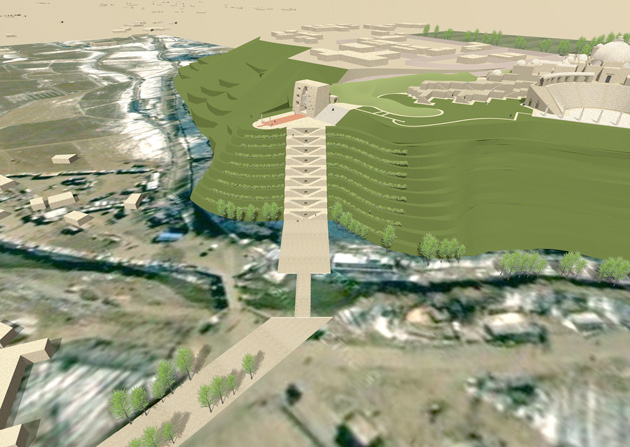 |
 |
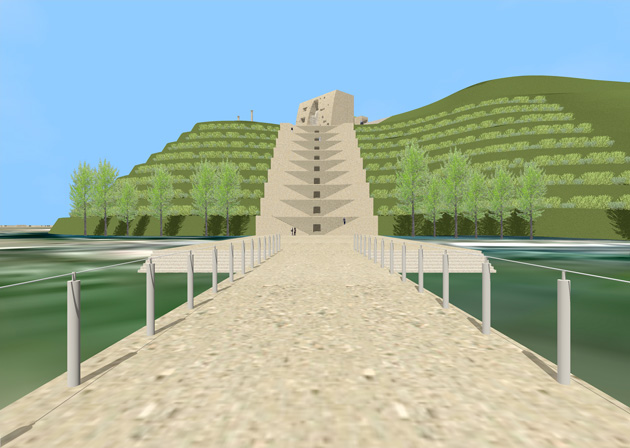 |
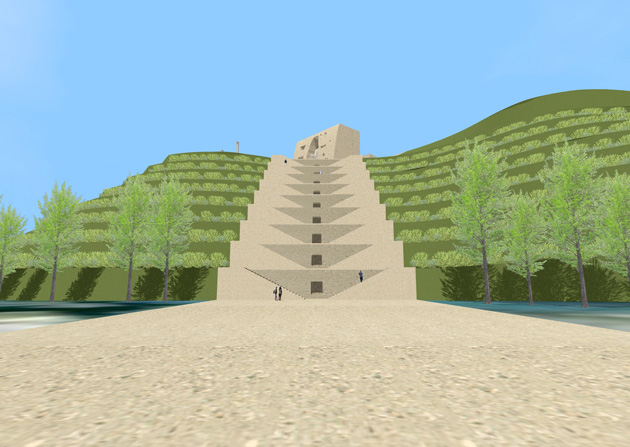 |
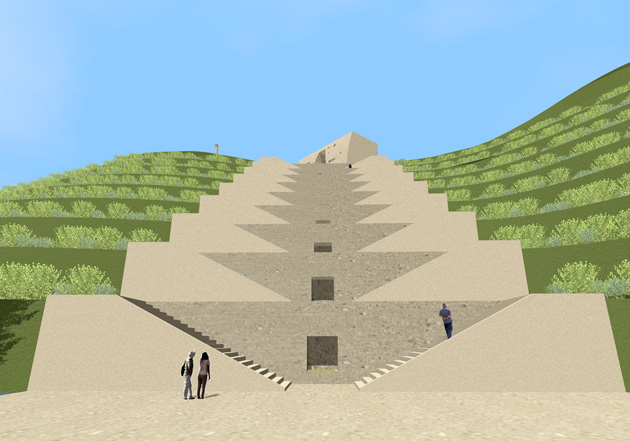 |
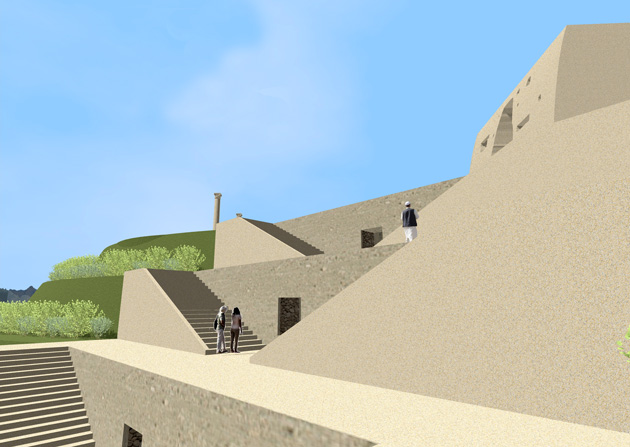 |
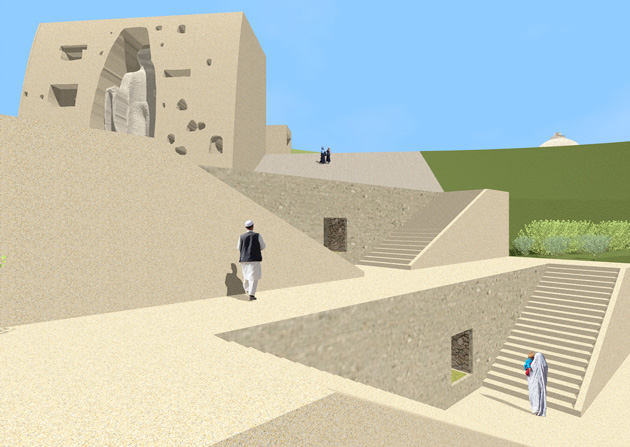 |
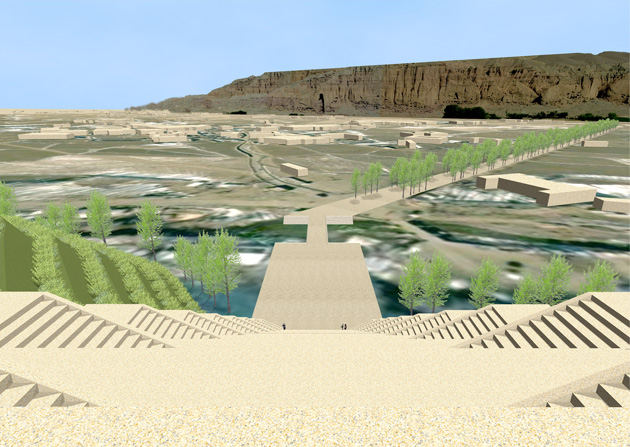 |
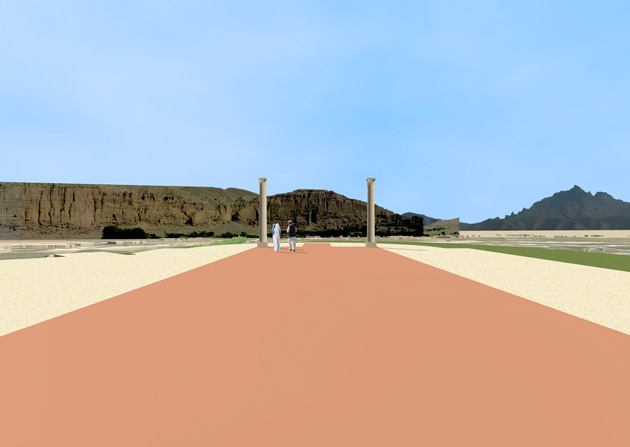 |
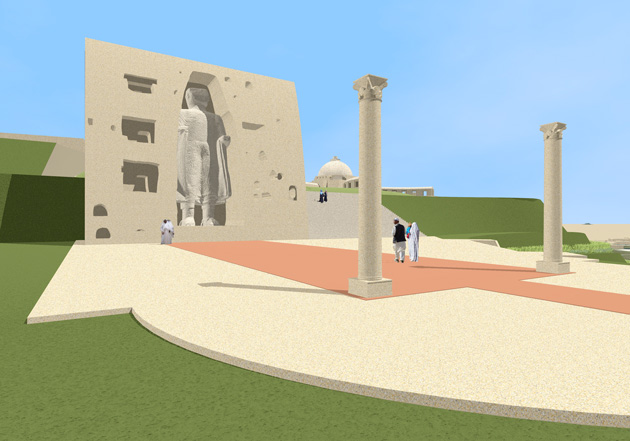 |
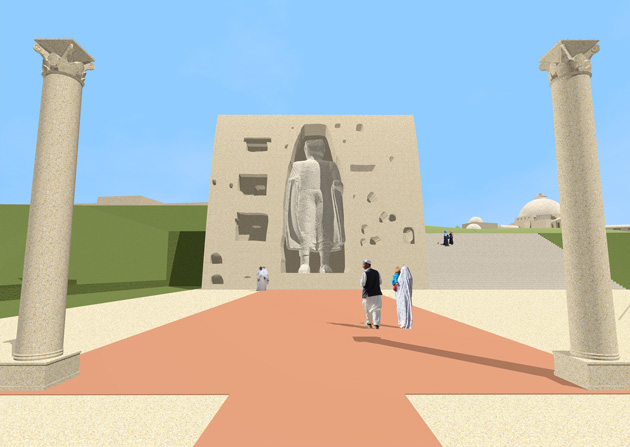 |
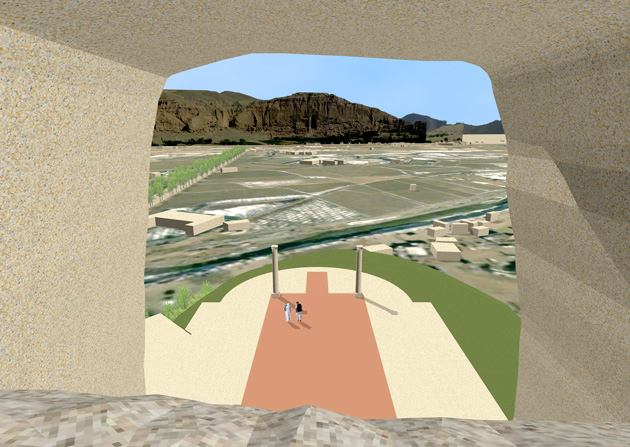 |
| Project Members |
| ��Project Director and Architectural Design
�@Shigeyuki OKAZAKI: Professor, Head, Department of Architecture, �@�@�@�@�@�@�@�@�@�@�@ Mukogawa Women's University �@ �@ ��Architectural Design and Edit �@ �@Noritoshi SUGIURA, �@ �@Aya YAMAGUCHI: �@ �@Department of Architecture, Mukogawa Women�fs University �@ �@ ��Planning �@ �@Kosaku MAEDA: Visitung Professor, Tokyo University of the Arts �@ �@Kazuya YAMAUCHI: Professor, Teikyo University
|